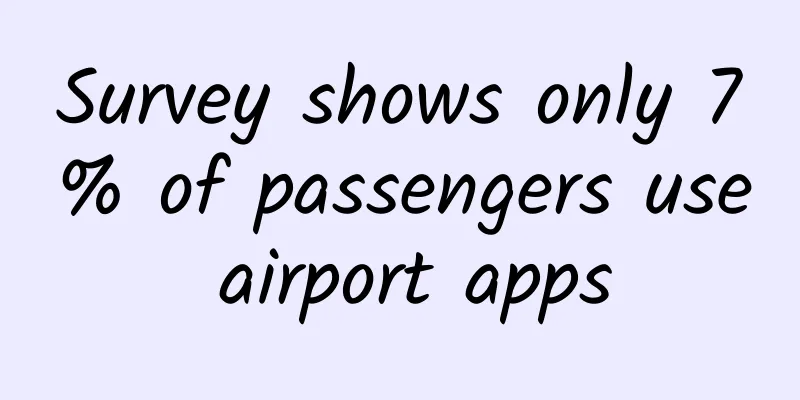Survey shows only 7% of passengers use airport apps

|
As consumers increasingly turn to smartphones to search, plan, book, record and share, the number of travel apps is growing rapidly. According to a survey by AppDynamics, an app performance management and IT operations analytics company owned by Cisco, 74% of travelers said apps and digital solutions played an important role in their journey. In the post-epidemic era, the penetration rate of travel apps has increased. In fact, in the summer of 2022, the number of downloads of travel apps exceeded the pre-epidemic level. Over the past decade, airports have also been catching up with the wave of digitalization and have launched their own apps in the hope of providing passengers with a better personalized experience. But the reality is that airport apps do not attract a large number of passengers, and most passengers don’t even bother to use airport apps. Siddhant Mehra, a researcher at Lufthansa Innovation Center, analyzed the reasons why airport apps are not popular. 01. Passengers hardly use airport apps The Lufthansa Innovation Center studied the top 20 airports in terms of passenger traffic in 2019 and found that only 7% of passengers departing from these airports would use the airport app, while the number of passengers using the airline app was about five times that of the former. Due to the small number of users, many airports have stopped operating their apps. This trend has become more obvious during the epidemic. Some airports have publicly announced the suspension of apps, while some airlines have chosen to quietly "kill" them.
As of now, among the top 20 airports in the world, only half of the airports’ apps are still usable, but the update speed of these apps is also declining, and the number of apps that will continue to operate in the future may become smaller and smaller. 02. Airports offer many opportunities to engage with passengers In theory, the airport can interact with passengers through many touch points from the time they enter the airport to the time they board their flight. When passengers arrive at the airport, they need to find a parking space, then go through security, during which time they need to pay attention to the flight status, and then they may have a meal or go shopping in a duty-free shop. As long as the app can provide relevant information and provide self-service, all of the above needs of passengers can be met. However, most airport apps fail to meet the needs of passengers. Of course, there are also some airport apps that are relatively successful. Let’s take a look at the following cases. Case 1: Schiphol Airport, Netherlands In 2016, Amsterdam's Schiphol Airport fully upgraded its app, making it more user-friendly, more responsive, and integrating AR maps to increase the level of personalization. This app can provide travel suggestions based on each passenger's itinerary and preferences. For example, it can estimate the arrival time at the airport based on flight information and push information to tell passengers how long it will take to pick up their luggage. Case 2: Hong Kong Airport In 2021, Hong Kong Airport launched a new version of the App with a more user-friendly interface and richer products. For example, if passengers purchase the baggage tracking tag MyTAG, they can receive notifications about the arrival time of their baggage. The app also provides AR navigation and pushes relevant activities near the traveler's location. Case 3: Changi Airport Singapore Changi Airport also has a high usage rate for its app, which not only tracks luggage but also provides products such as SIM cards and travel insurance. In April 2019, the app was upgraded with new features and interactions with other digital platforms. For example, travelers can import their flight schedule from their mobile phone calendar or plan their activities within the airport based on their stopover time and personal preferences. 03. The real dilemma faced by most airline apps We will find that airport apps are good at handling baggage-related matters, which is also one of the pain points in air travel. This means that if airport apps want to gain user favor, they need to solve this pain point. However, most airport apps do not truly enhance passengers’ experience at the airport; they simply provide basic flight-related information without generating any added value. Another aspect is that airport apps have to compete with airline apps, and in some respects, the former are at a natural disadvantage. A survey by Airport Dimensions, an airport experience service company, shows that 26% of passengers do not want to interact with the airport at all, even though the airport provides many opportunities for contact with passengers. The report pointed out that passengers are more inclined to check flight status on the airport website rather than obtain information through apps. More importantly, passengers prefer to search for air travel-related information through airline apps. 04.Why does this happen? The advantages of airline apps in ticket booking and check-in are obviously incomparable to those of airport apps. In order to check in, passengers must choose an airline and therefore download the airline's app. There is not much necessity for the airport app. In general, airport apps have "inherent deficiencies". They only provide non-essential services, cannot solve the real pain points faced by passengers, and are not differentiated from airline apps. How to break through limitations? Mehra said that there is still a lot of room for improvement in the application of digital technology in airports, and airport operators can improve passenger experience in the following aspects. 1) Increase capital investment and continue innovation Digital technology has touched every aspect of life. Airports should also keep up with the pace, upgrade their operating systems, improve efficiency, and provide passengers with a seamless experience. According to data from SITA, a global aviation industry IT supplier, airports will spend $6.8 billion on information and communications technology in 2022, up 28.3% year-on-year, but down 23% from 2019. Mehra said that if airports do not increase investment in the future, it will be difficult to change the status quo. 2) Develop an app that can truly solve pain points Convenience is always a core concern for passengers, and airline apps need to provide passengers with value-added services and convenience. Baggage tracking, fast security checks, lounge reservations, retail and food pre-ordering are all services that airports need to consider in depth. In their interactions with passengers, airports should also understand their actual needs and provide real services. For example, airports could allow passengers to reserve parking spaces before arriving at the airport, tell them the approximate wait time for security checks, or use biometric technology to provide self-service so that passengers can plan ahead. 3) Invest in long-term solutions To truly improve the passenger experience, airports need to plan for the long term. For example, you can consider using automation technology to save time for travelers, or use precise positioning technology to push relevant products and activities around travelers. Biometric technology is an integral part of airport security measures. Fingerprint and facial recognition systems can ensure that passengers pass through security checks accurately and quickly. Furthermore, with the addition of advanced algorithms, airports will be able to identify suspicious activities and behaviors, thus enhancing security without affecting passenger convenience. The combination of biometric systems and digital boarding passes can also minimize the risk of fraud and simplify the boarding process. 4) Establish cooperation with airlines Airports need to strengthen cooperation with airlines. For example, airports can integrate their products with airlines’ apps and leverage the latter’s high penetration rate to strengthen interaction with passengers. Airlines may also increase non-aviation revenue through cooperation between the two parties, which is a win-win result. 5) Shared Data To strengthen cooperation, airports need to provide application programming interfaces to partners and open up their data to them. According to SITA, 83% of airports consider data exchange technology an investment priority, but only 47% have related project plans before 2025. The application of artificial intelligence and machine learning technologies also requires data sharing. With data connectivity, airports can also make more efficient decisions in terms of safety and operational planning. Mehra pointed out that the app is just one of the channels for airports to connect with passengers, and airports should open their minds to explore more possibilities. Reference: Airport apps are dying out—what should airports do? (TNMT) Reprinted from | Travel Weekly |
>>: Ministry of Commerce: China E-commerce Report 2022
Recommend
Real or Fake Monkey King? Sorry, I am actually a little orchid~
Auditing expert: Yang Yanhui, Senior Garden Engin...
How many black wolfberries should be soaked in water at a time?
Our lives cannot be separated from water. Of cour...
It turns out that the “little tail” behind the shoes has such a big function!
Audit expert: Bi Siyi Lecturer, College of Textil...
Don't be obsessed with bananas when you are constipated! This fruit can help you defecate smoothly, it is cheap and delicious
Constipation has long been on the list of urban p...
24-hour emergency response: Raincoats of missing persons found in the wild during rescue operation in Ailao Mountain, Yunnan
Hot News TOP NEWS Raincoats of missing persons we...
UFOs spotted in the sky over many places, are they aliens or weapons from other countries? The truth is →
Around 6 p.m. on January 14, 2024, people in many...
Illustration丨Let’s talk about “artificial sun”: It’s difficult to make this, but it’s also very exciting!
Remember the movie "The Wandering Earth"...
The efficacy and function of Panax notoginseng
As we all know, Panax notoginseng is a very commo...
Want to know more about the zoo? This is not only fun, but also serious!
On January 25, representatives of the Chinese and...
Can ordinary people go into space and see the universe?
With a deafening roar, the rocket took off, and t...
Do you have unbearable stomach pain? Be careful! It may be...
I haven't had a bowel movement or passed gas ...
#There should be a sense of ritual during the New Year#, what exactly is a sense of ritual?
It's the Spring Festival again. What should w...
Spring is coming, is it going to rain caterpillars?
Audit expert: Li Guangwang Director of the Natura...
The efficacy and function of magnets
Magnet is a very common medicine in life. It is m...









